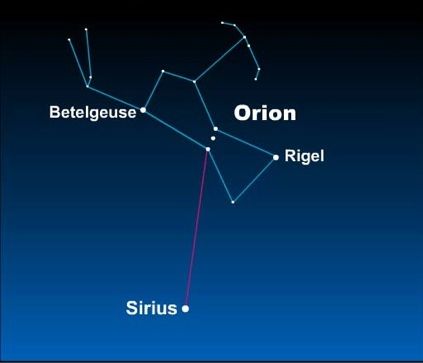2015 a great year for the Perseids!

 Courtesy U.S. Naval Observatory
Courtesy U.S. Naval Observatory
Top of post: Perseid (and other) meteors during the 2010 shower, as captured by Daniel McVey.
Tonight … meteors! And much more. Perseid meteor shower rises gradually to a peak, then drops off rapidly. So you’ll see some meteors after midnight tonight (morning of August 11, 2015), even though the following two mornings (August 12 and 13) are likely to be even better. Great news in 2015! The slender waning crescent moon won’t be rising until shortly before sunrise, so it won’t interfere with the shower.
The Perseid meteor shower favors the Northern Hemisphere because its radiant point is far to the north on the sky’s dome. But you’ll see meteors (though fewer in number) from the Southern Hemisphere, too.
The Perseids produce the most meteors in the dark hours before dawn. At its peak in the coming mornings, assuming you’ve got a dark and clear country sky, you might see some 50 to 100 meteors per hour.
Many skywatchers will be outdoors to watch this shower – especially on the expected peak mornings of August 12 or 13. Want more about watching meteors? Click here for all you need to know about Perseid meteors
Enjoying EarthSky so far? Sign up for our free daily newsletter today!

Perseid meteor over Mount Rainier. Photo by Jeff Berkes Photography.
Plus, as you watch these meteors picking up steam in the cool predawn hours, notice the friendly stars.
One of the easiest-to-spot constellations before dawn in August is Orion the Hunter. Look eastward just as dawn is beginning to break. We in the Northern Hemisphere think of Orion as a winter constellation, because he is best seen in the winter and spring evening sky. But in the cool of August mornings before dawn, early risers can experience these winter stars!
Orion’s prominent three-star belt lies in between its two brightest stars, Betelgeuse and Rigel. In the month of August, as Orion returns to the predawn sky, you can imagine the Hunter as a man lying on his back, with the star Betelgeuse as his right shoulder, and Rigel as his left knee.

After a night of meteor watching, watch for Orion to climb above the horizon shortly before dawn See the three medium-bright stars at the center of the constellation Orion? Those three stars are Orion’s Belt, and they’re very recognizable. Cool trick: Use Orion’s Belt to find the constellation Taurus the Bull.
At this time of year, Taurus the Bull is above Orion in the east before dawn. Orion’s Belt points to Aldebaran, the brightst star in Taurus. See the chart above.
If you wait until dawn is breaking, you might witness the return of Sirius, in the constellation Canis Major. Sirius is the sky’s brightest star. How to identify Sirius? Orion’s belt points to it, too. See the chart below.
Read more: Aldebaran is the Bull’s fiery eye
Read more: Sirius, Dog Star and brightest star

If you keep watching long enough for Orion to rise high enough in the sky, you’ll find that the three Belt stars of Orion point in the opposite direction to Sirius, Dog Star and sky’s brightest star.
Bottom line: Enjoy the Perseid meteor shower, as it rains down from late night until dawn on the mornings of August 12, 13 and 14, 2015! If you’re out until dawn, use the constellation Orion to locate the star Aldebaran in the constellation Taurus the Bull and the sky’s brightest star, Sirius, in the constellation Canis Major
Thanks to: http://earthsky.org
- 35


Tonight for August 10, 2015
 Courtesy U.S. Naval Observatory
Courtesy U.S. Naval Observatory Top of post: Perseid (and other) meteors during the 2010 shower, as captured by Daniel McVey.
Tonight … meteors! And much more. Perseid meteor shower rises gradually to a peak, then drops off rapidly. So you’ll see some meteors after midnight tonight (morning of August 11, 2015), even though the following two mornings (August 12 and 13) are likely to be even better. Great news in 2015! The slender waning crescent moon won’t be rising until shortly before sunrise, so it won’t interfere with the shower.
The Perseid meteor shower favors the Northern Hemisphere because its radiant point is far to the north on the sky’s dome. But you’ll see meteors (though fewer in number) from the Southern Hemisphere, too.
The Perseids produce the most meteors in the dark hours before dawn. At its peak in the coming mornings, assuming you’ve got a dark and clear country sky, you might see some 50 to 100 meteors per hour.
Many skywatchers will be outdoors to watch this shower – especially on the expected peak mornings of August 12 or 13. Want more about watching meteors? Click here for all you need to know about Perseid meteors
Enjoying EarthSky so far? Sign up for our free daily newsletter today!

Perseid meteor over Mount Rainier. Photo by Jeff Berkes Photography.
Plus, as you watch these meteors picking up steam in the cool predawn hours, notice the friendly stars.
One of the easiest-to-spot constellations before dawn in August is Orion the Hunter. Look eastward just as dawn is beginning to break. We in the Northern Hemisphere think of Orion as a winter constellation, because he is best seen in the winter and spring evening sky. But in the cool of August mornings before dawn, early risers can experience these winter stars!
Orion’s prominent three-star belt lies in between its two brightest stars, Betelgeuse and Rigel. In the month of August, as Orion returns to the predawn sky, you can imagine the Hunter as a man lying on his back, with the star Betelgeuse as his right shoulder, and Rigel as his left knee.

After a night of meteor watching, watch for Orion to climb above the horizon shortly before dawn See the three medium-bright stars at the center of the constellation Orion? Those three stars are Orion’s Belt, and they’re very recognizable. Cool trick: Use Orion’s Belt to find the constellation Taurus the Bull.
At this time of year, Taurus the Bull is above Orion in the east before dawn. Orion’s Belt points to Aldebaran, the brightst star in Taurus. See the chart above.
If you wait until dawn is breaking, you might witness the return of Sirius, in the constellation Canis Major. Sirius is the sky’s brightest star. How to identify Sirius? Orion’s belt points to it, too. See the chart below.
Read more: Aldebaran is the Bull’s fiery eye
Read more: Sirius, Dog Star and brightest star

If you keep watching long enough for Orion to rise high enough in the sky, you’ll find that the three Belt stars of Orion point in the opposite direction to Sirius, Dog Star and sky’s brightest star.
Bottom line: Enjoy the Perseid meteor shower, as it rains down from late night until dawn on the mornings of August 12, 13 and 14, 2015! If you’re out until dawn, use the constellation Orion to locate the star Aldebaran in the constellation Taurus the Bull and the sky’s brightest star, Sirius, in the constellation Canis Major
Thanks to: http://earthsky.org






 Sat Mar 23, 2024 11:33 pm by globalturbo
Sat Mar 23, 2024 11:33 pm by globalturbo

